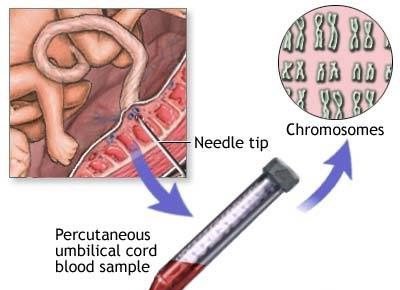Umbilical cord blood aspiration in prenatal diagnosis
This article was professionally consulted by Specialist Doctor I Truong Nghia Binh - Obstetrician-Gynecologist - Department of Obstetrics and Gynecology - Vinmec Da Nang International General Hospital. Doctor has more than 13 years of experience in the field of Obstetrics and Gynecology.
Umbilical cord aspiration in prenatal diagnosis to diagnose fetal abnormalities, is performed when the fetus is about 11-13 weeks old.
1. Factors leading to birth defects in the fetus
Many factors can lead to birth defects in an unborn baby. The change of environment, climate has had many effects on human reproduction. The heavy consequences of Agent Orange during the war left a state of illness and disease affecting many generations.
Currently, besides a number of common bacterial infections, a number of diseases and defects in fetuses and newborns originate from the following main causes:
Genetic aberrations including chromosomal abnormalities, genetic disorders, metabolic disorders... During pregnancy, mothers are exposed to toxic environments such as chemicals, air, soil, water..., the mother takes some drugs in the first 3 months of pregnancy. pregnancy; The mother has infections during pregnancy such as: Syphilis, Rubella, urinary tract infections, genital infections... The problem of prenatal diagnosis allows the identification of morphology, and abnormalities of body surface of the fetus. Thereby, depending on the degree of deformity of each case, doctors will proceed to remedy or give advice to the family whether to keep or abort the pregnancy as well as how to monitor and care for the baby after birth.
Currently, besides a number of common bacterial infections, a number of diseases and defects in fetuses and newborns originate from the following main causes:
Genetic aberrations including chromosomal abnormalities, genetic disorders, metabolic disorders... During pregnancy, mothers are exposed to toxic environments such as chemicals, air, soil, water..., the mother takes some drugs in the first 3 months of pregnancy. pregnancy; The mother has infections during pregnancy such as: Syphilis, Rubella, urinary tract infections, genital infections... The problem of prenatal diagnosis allows the identification of morphology, and abnormalities of body surface of the fetus. Thereby, depending on the degree of deformity of each case, doctors will proceed to remedy or give advice to the family whether to keep or abort the pregnancy as well as how to monitor and care for the baby after birth.

Dị tật thai nhi có thể bắt nguồn từ sai lệch di truyền
2. Measures to diagnose birth defects
Prenatal diagnostic measures include:
Genetic testing Ultrasound spine biopsy Amniocentesis Amniocentesis umbilical cord blood aspiration Mother's blood DNA test Maternal blood test Triple test.
Genetic testing Ultrasound spine biopsy Amniocentesis Amniocentesis umbilical cord blood aspiration Mother's blood DNA test Maternal blood test Triple test.
3. Learn the method of umbilical cord blood aspiration in prenatal diagnosis

Phương pháp chọc hút máu cuống rốn trong chẩn đoán trước sinh được thực hiện khi có chỉ định của bác sĩ
The method of umbilical cord blood aspiration in prenatal diagnosis is performed when prescribed by a doctor, in order to diagnose abnormalities of the fetus. Umbilical cord aspiration technique is performed when the fetus is 11-13 weeks old.
Prenatal diagnoses in cord aspiration include:
Chromosomal analysis: Abnormal pregnancy Edema Genetic pathology: Hemophilia, myasthenia gravis Blood group assessment: Rh, IPT Infection: Rubella, Parvo B19, Herpes, CMV Assess fetal health: PO2, pCO2, pH, Hb Under ultrasound guidance, a needle is inserted through the abdominal wall of the pregnant woman into the uterus, then into the blood vessels in the umbilical cord, about 1cm from the placenta. A small amount of blood is taken for testing and diagnostic results in cases of suspected anemia, measles infection, toxoplasmosis, herpes, or fetal growth retardation. The risk of fetal harm when performing this method is quite high, from 1-2%.
In summary, there are many methods of prenatal diagnosis to detect abnormalities of the fetus. Umbilical cord aspiration in prenatal diagnosis is performed when the fetus is 11-13 weeks of pregnancy, and is performed when ordered by the doctor to diagnose abnormalities.
Prenatal diagnoses in cord aspiration include:
Chromosomal analysis: Abnormal pregnancy Edema Genetic pathology: Hemophilia, myasthenia gravis Blood group assessment: Rh, IPT Infection: Rubella, Parvo B19, Herpes, CMV Assess fetal health: PO2, pCO2, pH, Hb Under ultrasound guidance, a needle is inserted through the abdominal wall of the pregnant woman into the uterus, then into the blood vessels in the umbilical cord, about 1cm from the placenta. A small amount of blood is taken for testing and diagnostic results in cases of suspected anemia, measles infection, toxoplasmosis, herpes, or fetal growth retardation. The risk of fetal harm when performing this method is quite high, from 1-2%.
In summary, there are many methods of prenatal diagnosis to detect abnormalities of the fetus. Umbilical cord aspiration in prenatal diagnosis is performed when the fetus is 11-13 weeks of pregnancy, and is performed when ordered by the doctor to diagnose abnormalities.
Để đặt lịch khám tại viện, Quý khách vui lòng bấm số HOTLINE hoặc đặt lịch trực tiếp TẠI ĐÂY. Tải và đặt lịch khám tự động trên ứng dụng MyVinmec để quản lý, theo dõi lịch và đặt hẹn mọi lúc mọi nơi ngay trên ứng dụng.
Bài viết này được viết cho người đọc tại Sài Gòn, Hà Nội, Hồ Chí Minh, Phú Quốc, Nha Trang, Hạ Long, Hải Phòng, Đà Nẵng.






